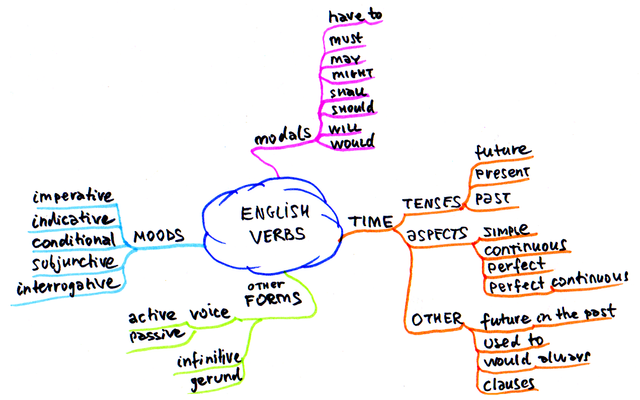Learning English Together: All You Need to Know About Tenses

In this post I’m going to summarize the most important points about English tenses I’ve learned so far. For me as a non-native speaker, it’s one of the most confusing topics in all of English grammar, because there are many verb forms expressing time reference in English and some of them look similar but have different meanings.
They say the best way to learn something is to explain it to others, so this summary is meant as a reference both for myself and for other non-native speakers. I did my best to make it mistake free, but if you find one, let me know in comments — I’m in no way an English expert.
The Big Picture
Well, I once heard a story of the past, the present, and the future walking into a bar. I am sad to say that it was tense.
First of all, let’s see where this topic is located in a wider context of English verbs:
As you can see, the most complex topics are forms related to time, modals, and moods (especially conditional). By the way, mind mapping is a great tool for studying languages — I’ll write about it in more detail in one of my next posts.
A note on the terminology. A tense refers to time, while an aspect refers to the way an action is happening (for example, whether it’s already finished or is an ongoing process). There are three tenses in the table below — past, present, and future. The rest are aspects. By combining the three tenses with the four aspects we get twelve forms. (By the way, not everyone agrees that future is a tense, but we won’t dig that deep.)

On the table above English tenses and aspects are looking like a very well-thought system, but, unfortunately, it’s only a superficial impression. English is not a system with consistent rules, it’s rather a conglomerate of particular use cases. For example, present perfect belongs to the past at least as much as to the present, and perhaps could be better understood as a form of past tense.
The problem with this table is that its logic (in fact, any logic) doesn’t help us to quickly decide what form to use. I can’t imagine a normal person stopping in the middle of a conversation to try aligning the events she’s speaking about along the famous timeline from English textbooks.
Memory doesn’t work like this. Instead, correct usage is triggered by context. If we learn the trigger words and contexts and become used to discerning them during a conversation, then we will easily choose the right tense/aspect. So my approach is to read and exercise as much as possible instead of trying to memorize complex rules.
Nevertheless, here are the rules, or rather, as I said before, the use cases.
Present

Since there is no time like the present, he thought it was time to present the present.
Simple Present
Example: I study.
It’s not so simple even with the simple present, the simplest of all verb forms. We use the simple present to talk about something that is true in the present (“I live in London”), or is always true (“The sun is 93 million miles from the Earth”), or happens again and again in the present (“I do yoga twice a week”), but also when something is fixed in the future (“A post’s payout happens in seven days”).
Present Continuous
Example: I am studying.
Present continuous feels intuitive, but is actually a collection of use cases. We use the present continuous to talk about an action happening at the moment of speaking (“I’m studying English now”), but also when something is happening around a given time (“I’m usually studying English in the evening”), or again and again (“It’s always raining here”), or when something is temporary (“I’m studying English for the next two hours”). We also use it when speaking about something which is changing, growing, or developing (“My English is improving”), or when something contrasts with a previous state (“Nowadays most people are using computers to study English”), or when speaking about something which has been planned (“What are you doing next week?”).
Present Perfect
Example: I have studied.
— How do you know that carrots are good for the eyes?
— Have you seen a rabbit wearing glasses?
If we arrange verb forms by their complexity to learn for non-native speakers, I bet that the first place will be taken by the present perfect. It’s a large collection of different contexts. If we manage the present perfect, other aspects will take their right places in our mind soon.
We use the present perfect for something that started in the past and continues in the present (“She has lived in London since childhood”), or, on the contrary, has changed over time (“Governments have become more interested in cryptos since last year”), or for something we have done several times in the past and continue to do (“He has written six books and he is working on another one”), or when we are talking about our experience up to the present (“I have been to London”). We also use it for something that happened in the past but is important at the time of speaking (“I can’t get in the house. I’ve lost my keys), or when we are referring to the recent past, with trigger words like “just” or “recently” (“I have just finished my work”). We also use the present perfect with adverbials referring to the present, like ever, so far, until now, and yet (“Have you ever seen a ghost?”).
Present Perfect Continuous
Example: I have been studying.
As I said, if we master the present perfect, the other aspects will follow. The present perfect continuous is similar to the present perfect: we are speaking about something that started but did not finish in that period of time (“I’ve been writing for the last hour”) or finished just recently, with more focus on the process (“I’ve just been practicing my English”).
Past

Simple Past
Example: I studied.
— Why did Shakespeare only write in ink?
— Pencils confused him — 2B or not 2B?
Simple past is what many non-native speakers normally use when speaking about the past. But its actual use is more nuanced and limited with several cases. We use the simple past to talk about something that happened once in the past (“I met my wife in 1992”), or something that happened again and again in the past (“We always enjoyed visiting our friends”), or something that was true for some time in the past (“I lived abroad for ten years”). Trigger words: when, ago, often, sometimes, always, yesterday, last week, at five o'clock etc.
Past Continuous
Example: I was studying.
We use the past continuous to talk about something which continued before and after another action (“The children were doing their homework when I got home”), or something that happened before and after a particular time (“In May she was blogging a lot”), or to show that something continued for some time (“Everyone was shouting”), or something that was happening again and again (“They were meeting secretly after school”). It’s also used with verbs which show change or growth (“My English was improving”).
Past Perfect
Example: I had studied.
— Don't you know the Queen's English?
— Why, yes, I'd heard she was.
We use the past perfect to express the idea that something occurred before another action or before a specific time in the past (“She had never seen a bear before she moved to Russia”). We also use it to talk about the past in conditions, hypotheses, and wishes (“I wish I hadn’t spent so much bitcoin last month”). Trigger words: when, before, after, since.
Past Perfect Continuous
Example: I had been studying.
We use the past perfect continuous to show that something started in the past and continued up until another time in the past (“How long had you been waiting to get on the bus?”) or to show cause and effect (“He was tired because he had been jogging”).
Future

Simple Future
Example: I will study; I am going to study.
Simple future refers to a specific time in the future. This is the only simple thing about it; the rest is complicated as it has different forms which aren’t always interchangeable: “will,” “shall” (dated), and “be going to.”
We use simple future to predict a future event (“It will rain tomorrow” or “John Smith is going to be the next president”), to express a voluntary action (“I'll do the washing-up”) or a plan (“I'm going to be an actor when I grow up”), to give orders (“You will do exactly as I say”) or an invitation (“Will you come to the dance with me?”), to make an offer or a suggestion (“Shall we go to the cinema tonight?), or to ask for advice (“What shall I tell the investors about this money?”).
Future Continuous
Example: I will be studying; I am going to be studying.
We use the future continuous to show that a longer action in the future will be interrupted by a shorter action (“He will be studying at the library tonight, so he will not see her when she arrives”). We can use a specific time as a kind of interruption (“Tonight at six pm, I am going to be eating dinner”). Future continuous has two interchangeable forms: "will be doing" and "be going to be doing."
Future Perfect
Example: I will have studied; I am going to have studied.
We use the future perfect to show that something will happen before another action or a specific time in the future (“You will have perfected your English by the time you finish reading this article”), or will continue up until another action in the future (“I will have been in London for three months by the time I leave”). Future perfect has two interchangeable forms: "will have done" and "be going to have done."
Future Perfect Continuous
Example: I will have been studying; I am going to have been studying.
We use the future perfect continuous to show that something will continue up until a particular event or time in the future (“How long will you have been studying when you graduate?”). It can also be used to show cause and effect (“Her English will be perfect when she returns home because she is going to have been studying English in London for two years”). Future perfect continuous has two interchangeable forms: "will have been doing" and "be going to have been doing."
That’s all about tenses and aspects. I don’t cover here other verb forms like future in the past, “used to,” or “would always.”
Oh, and if you want to write really well, don’t forget about these rules! :)
My Related Posts
Useful Links and Resources
- Learn English by British Council
- Tense–aspect–mood
- Grammarly Blog
- englishgrammar.org
- oxforddictionaries.com

Whoa, very thorough write up here. Helpful for me to refresh my English writing skill! Thanks man!
You're welcome! :)
😄
Congratulations! This post has been upvoted from the communal account, @minnowsupport, by vitkolesnik from the Minnow Support Project. It's a witness project run by aggroed, ausbitbank, teamsteem, theprophet0, someguy123, neoxian, followbtcnews/crimsonclad, and netuoso. The goal is to help Steemit grow by supporting Minnows and creating a social network. Please find us in the Peace, Abundance, and Liberty Network (PALnet) Discord Channel. It's a completely public and open space to all members of the Steemit community who voluntarily choose to be there.
If you would like to delegate to the Minnow Support Project you can do so by clicking on the following links: 50SP, 100SP, 250SP, 500SP, 1000SP, 5000SP. Be sure to leave at least 50SP undelegated on your account.
Grammar is boring.